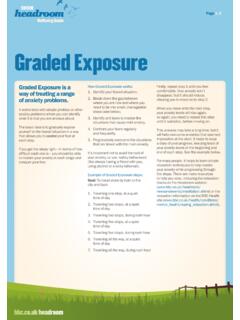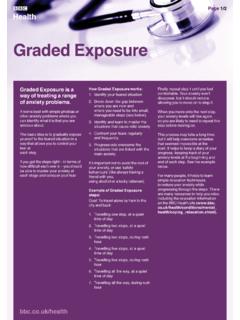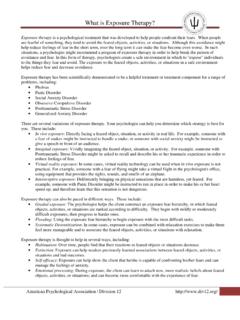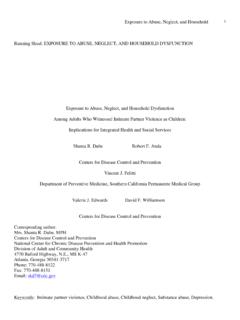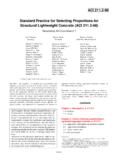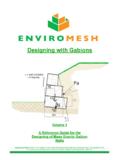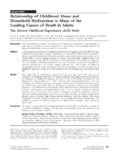Transcription of Evidence based literature review - Health and Safety …
1 Health and Safety Executive Evidence for exposure and harmful effects of diathermy plumes (surgical smoke) Evidence based literature review Prepared by the Health and Safety Laboratory for the Health and Safety Executive 2012 RR922 Research Report Health and Safety Executive Evidence for exposure and harmful effects of diathermy plumes (surgical smoke) Evidence based literature review Alan Beswick & Gareth Evans Health and Safety Laboratory Harpur Hill Buxton Derbyshire SK17 9JN The methods used to dissect tissue and stem blood flow during surgery have changed as technology has developed.
2 Lasers and electro-surgery have become commonplace, so that medical staff in the operating theatre are (potentially) increasingly exposed to the thermal decomposition products of tissues. Variations in ventilation systems and the presence or absence of local exhaust ventilation are likely to influence the extent to which this occurs. A systematic review was carried out to identify existing Evidence about surgical smoke (known as diathermy plume) and the potential harm to Health care workers exposed in operating theatres.
3 Limited published data were identified, but indicated that dedicated smoke evacuation/extraction devices are effective at reducing the levels of surgical smoke during various surgical procedures, and that correct (close) positioning of smoke evacuation devices to source emissions is likely to be important to the efficiency of surgical smoke removal. The data were insufficient to allow conclusions to be drawn on reported respiratory ill Health symptoms linked with surgical smoke exposure . This report and the work it describes were funded by the Health and Safety Executive (HSE).
4 Its contents, including any opinions and/or conclusions expressed, are those of the authors alone and do not necessarily reflect HSE policy. HSE Books Crown copyright 2012 First published 2012 You may reuse this information (not including logos) free of charge in any format or medium, under the terms of the Open Government Licence. To view the licence visit , write to the Information Policy Team, The National Archives, Kew, London TW9 4DU, or email Some images and illustrations may not be owned by the Crown so cannot be reproduced without permission of the copyright owner.
5 Enquiries should be sent to ACKNOWLEDGEMENTS HSL would like to thank Diane Llewellyn, Philip Roberts (HSE) and David Fishwick and Anil Adisesh (HSL) for their contribution to the co-reviewing of scientific papers for this report process. ii CONTENTS MAIN v EXECUTIVE vii Members of the literature review assessor ix 1 Introduction and context.
6 1 2 Methodology .. 3 Agreed approach and scope of the review .. 3 External partner involvement the assessor 3 Development of review questions .. 3 review questions and their PICO-format Systematic literature 4 Agreed search boundaries ..4 The search process ..4 review of abstracts and other related Critical appraisal of papers .. 7 Evidence 7 Considered judgement forms and Evidence statements .. 7 Key Evidence - based conclusions .. 8 review of additional 3 10 Primary search output and paper exclusions.
7 10 Evidence Considered judgement Evidence statements and Conclusions ..20 Knowledge Gaps ..22 Impact of 4 References .. 25 Papers cited within the main text but not systematically reviewed .. 25 Papers used for systematic 5 Appendices .. 27 Appendix 1 -Agreed search terms as related to PICO questions .. 27 Appendix 2 -Search algorithms used by HSE Infocentre search as based on search terms described Appendix 3 - Evidence iii iv
8 MAIN MESSAGES This systematic review has considered the Evidence related to the use of surgical smoke evacuation devices, and their role in reducing the exposure of UK healthcare workers (HCWs) to smoke exposure in the surgical environment. Over recent years a small number of individual UK case reports have attributed such exposure to HCWs developing respiratory ill Health due to exposure of this nature.
9 Although there are existing legal requirements within the UK for all workers to be protected from unnecessary exposure to hazardous materials, a key issue related to surgical smoke is whether there is Evidence that the unpleasant, cloying, odorous smoke actually equates to a hazard, and in turn whether this poses a risk to workers exposed to it. Despite the small number of cases in the UK where HCWs have reported ill Health attributed to surgical smoke exposure , there is no specific legal requirement for surgical departments to install smoke extraction systems for any type of surgical procedure.
10 This is despite the fact that certain tissue cutting devices and types of surgery are known to generate more smoke and aerosols than others. Where a risk assessment indicates, COSHH regulations may apply in the operating theatre environment, as some published reports conclude that hazardous substances can be associated with surgical smoke. Under such circumstances employer must comply with the COSHH regulations to control the exposure of their staff to these substances.










